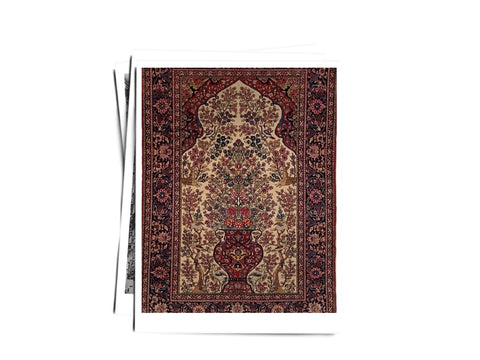BUYERS GUIDE
You may wish to purchase a Persian carpet to add to your personal collection or to have as the center piece in your home or the desired location you have in mind.
Like any kind of art piece, there are many nuances to a Persian rug. To start you off, we recommend that you consider four main factors that play a big role in quality as well as value.
Design
Perhaps the most important feature of a carpet is its design. More intricate designs involve greater workmanship both on the part of the artist and the weaver and therefore have a direct impact on the value of the piece.

Geometric Designs
Geometric designs are made up of repeated vertical, horizontal and diagonal lines. These carpets are usually woven by nomadic tribes using certain traditional and cultural symbols as motifs. Given the relative simplicity of the design, tribal pieces tend to be less sophisticated in terms of the required technical know-how. Consequently, these carpets usually lack full symmetry and color consistency giving them a 'primal' quality and making them less expensive.

Curvilinear and Floral Designs
Most of the elements in the curvilinear and floral designs have meaning that reflects their close affinity with nature which is why small plants, flowers or delicate animals, can be seen in almost all carpets. The most common motif is the central medallion. When evaluating curvilinear and floral designs, the composition, detailing and symmetry are factors to consider.

Pictorial Designs
Perhaps the rarest of Persian rug styles is the pictorial design. This type of pattern doesn't follow a standard outline and each rug is unique in its details. The weaving of a pictorial rug demands much more skill from the weaver because unlike curves, circles, or repetitive floral elements, it is more difficult to weave details and smaller elements that require great accuracy.
Color
Color Scheme
The combination of colors in a Persian carpet has an important effect on the value of your rug. As the number of colors used increases so does the value of the carpet. In museum quality rugs produced by master weavers, the number of colors could be as high as 250. It takes years of experience and knowledge to create rugs with such complex coloration. Of course, it is equally important that the artist's choice of colors results in a harmonious palette with desirable aesthetics for the piece.
Color Sources
There are two types of dyes that are used in the production of carpets: chromic or synthetic dyes, and natural dyes. Chromic dyes are easier to work with and allow a for a greater selection of colors. As a result, natural dyes tend to be more commonly used in carpets that have simpler color schemes.
Primary Color Natural Dyes Used
Black Logwood plants
Blue Indigo plants
Brown Tannin and oak tree galls
Green Turmeric berries
Khaki Nuts or tree bark
Pink Depleted madder
Red Root of wild madder
Yellow Saffron & pomegranate plant
Material
Persian carpets are made from either wool, silk or a combination. Cotton is also used as a foundation for the warps and wefts (refer to the glossary).
Wool
Wool is the most common material used for its durability and versatility. There is a wide variety of wool used in carpet weaving, each with different properties. Wool carpets tend to have a coarser texture than silk and are woven with a lower knot density. However wool carpets are very durable and can hold up nicely with foot traffic or the weight of furniture.
The wool used in Persian carpets is most usually sheep’s wool but other sources also includecork wool (underbelly of the lamb), Manchester wool and camel hair wool. The lamb and sheep that produce the wool are from the mountainous regions of Iran where the harsh winters necessitate a thick coat for the animals.
The choice of wool depends on the quality of the carpet that the artist is producing. For example, cork and sheep’s wool tend to be much softer in texture and are used in higher quality rugs.
Silk
The silk used in Persian carpets comes from a combination of domestic and imported suppliers. Silk carpets are less common than wool carpets since silk is more expensive and is not used for mass production. Carpets made from silk tend to be much finer and more intricate and generally of a much higher artistic value.
Knot Density
The number of knots per square inch (KPS) is important in determining the texture and the finesse of the carpet.
A higher knot density will result in a much finer surface texture and will allow for a more intricate pattern detail much in the way your TV’s pixel density or resolution determines the quality of the images the TV is able to support.
The table below serves as a rough guide for the relationship between KPS density and quality.
| Relationship Between KPS and Quality | ||||
| Knots/1 cm | Knots/1 inch | RAJ | KPSI | Quality |
| 3.57 or less | 9.07 or less | 25 or less | 82 or less | Very poor |
| 3.85 | 9.70 | 27 | 82 | Poor |
| 4.28 | 10.88 | 30 | 118 | Acceptable |
| 5.00 | 12.70 | 35 | 161 | Medium |
| 7.14 | 18.14 | 50 | 329 | Good |
| 8.57 | 21.77 | 60 | 474 | Great |
| 10.00 | 25.40 | 70 | 654 | Excellent |
| 11.42 | 29.02 | 80 | 843 | Superb |
| 12.85 | 32.65 | 90 | 1066 | Masterpiece |
| 13.14 or more | 33.38 or more | 92 or more | 1144 or more | Museum types |
